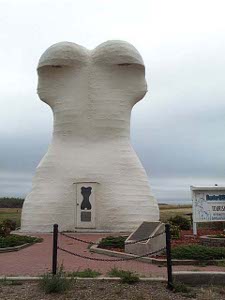 Grain elevator
Grain elevator
In Prince Albert, the farmers and ranchers were talking about the drought; in Edmonton the newspapers were writing about it. Outside the city we saw farm ponds dried up, with caked and cracked mud looking for all the world like a desert dry lake. One farmer told us at lunch the hay was too short to bale. Some farmers have switched back to their old hay balers; evidently the tiny rectangular bales will hold together even with shorter grasses.
 Grain elevator
Grain elevator
The Edmonton RCMP checked out a story of a rancher who allegedly shot his cattle and then himself: it's a rural version of an urban legend, the kind of story people repeat over coffee.
The rain this week was too late; the growing season is too short. As if to prove it, there was a snow flurry near Calgary.
Driving east again, we passed trucks loaded with hay as well as empty cattle trucks. They were heading west, donated by more fortunate farmers to help the western herds survive the winter.
The whole thing reminded us of a sad story from our genealogy. Great Uncle Jack was a rancher and a plunger, and bought a huge herd of calves in New Mexico. He brought them to his Kansas ranch, but the winter was gruesome, and the railroad reneged on its promise to send cattle cars to help Jack save the herd. The cattle were lost, the banks foreclosed, and Jack was ruined.
Luck and risk management have always played a big role in farming. The farmer who is too conservative can't make a living, because the prices for farm products are lowered by the high productivity caused by those who invest heavily in stock and equipment.
As we drove through the great plains and saw the vast majority of the land devoted to agriculture, we found it easy to forget that the vast majority of the population work in the cities.
We appreciate the beauty of the farm belt. This lovely rolling land was once covered with wild grasses and bison; now it's patched with huge fields of crops and dotted with herds of cattle. The trees here were planted by men, for shade and beauty and as windbreaks. The towns are spaced far apart, and distinguished by the towering grain elevators next to the railroad tracks.
We thought we'd become accustomed to displays of local customs, but we were startled by the sight of The World's Largest Bunnock, a tall, white sculpture which happened to house the Visitor Information Center for Macklin, Saskatchewan, Canada (see attached photo.) The following information was provided by way of explanation.
"The game of Bunnock was first introduced to Canada by the Russian Germans. There are several versions of how the game originated. One of them is that the game was developed in the early 1800's by the Russian military. Some old timers remember stories told by their elders relating how the Russian soldiers posted in the frozen tundra of northern Siberia, found the time endless. To help pass the time they tried to play horseshoes, but all too often they found it impossible to drive the peg into the frozen ground. With a little ingenuity, or was it sheer luck or boredom, some of the Russian soldiers discovered that the ankle bones of a horse could be set up on the frozen ground and so a new game called Bunnock (Bones) was born.
 World's Largest Bunnock
World's Largest Bunnock
"Bunnock was a free form of entertainment. Because horses were the only form of transportation, they were plentiful and the bones of long dead animals could be found throughout the countryside. This made the game affordable for all, even the poorest of peasants. The bones were often used as nature had left them, weathered and bleached by the sun. To identify the different positions the bones would be marked on the back with a steel file. Often the bones would be carved with different Roman numerals to identify the position. Today the bones are usually painted different colors for different positions.
"The Germans from Russia adopted the game while still living in Russia. Many a Sunday was spent with family and neighbors in a friendly game of Bunnock. The game was also a favorite at the second day of a wedding. Originally the game was played by only men, but over the years it became co-ed.
"The game of Bunnock consists of 52 bones. The eight heaviest are marked as Schmeiser (throwers) while four more are marked as guards. The rest are ordinary soldiers. The guards and soldiers are equally divided, then set on level ground in two straight lines, 10 metres apart. The rules of the game call for an equal number of players on either side (usually four) who will try to knock down the opposing teams bones with the throwers. The guards must be knocked down first or penalties will be given. Each team takes turns throwing and the team which knocks down the opponents bones first is declared the winner. It sounds simple, but it is a game of skill and accuracy. As everyone who plays it soon finds out, it is very enjoyable and challenging. "